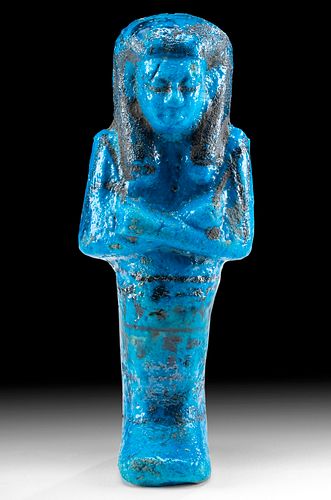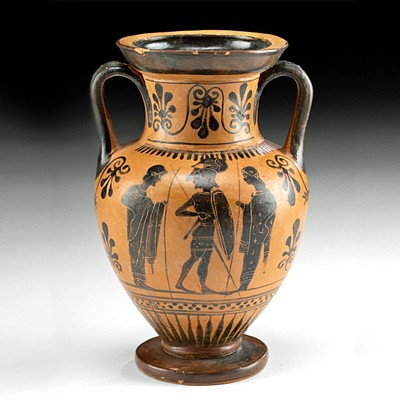Egyptian New Kingdom Faience Ushabti, TL'd
About Seller
686 S Taylor Ave, Ste 106
Louisville, CO 80027
United States
Selling antiquities, ancient and ethnographic art online since 1993, Artemis Gallery specializes in Classical Antiquities (Egyptian, Greek, Roman, Near Eastern), Asian, Pre-Columbian, African / Tribal / Oceanographic art. Our extensive inventory includes pottery, stone, metal, wood, glass and textil...Read more
Two ways to bid:
- Leave a max absentee bid and the platform will bid on your behalf up to your maximum bid during the live auction.
- Bid live during the auction and your bids will be submitted real-time to the auctioneer.
Bid Increments
| Price | Bid Increment |
|---|---|
| $0 | $25 |
| $300 | $50 |
| $1,000 | $100 |
| $2,000 | $250 |
| $5,000 | $500 |
| $10,000 | $1,000 |
| $20,000 | $2,500 |
| $50,000 | $5,000 |
| $100,000 | $10,000 |
| $200,000 | $20,000 |
About Auction
Mar 9, 2023
Artemis Fine Arts info@artemisgallery.com
- Lot Description
Ancient Egypt, New Kingdom, 18th to 19th Dynasty, ca. 1550 to 1189 BCE. A stunning funerary figure of tall form called an overseer ushabti that is mold-formed from faience and enveloped in layers of brilliant blue glaze. Standing atop broad feet with fused legs, the figure presents with raised arms crossed atop the chest and holding a a pick and a hoe for tending the fields of Osiris in the Afterlife; a black seed bag is painted along the verso and hangs between both shoulders. The dignified visage exhibits almond-shaped eyes above a perky nose, full lips, and flared ears framed beneath the lappets of a black-painted wig. Three lines of black hieroglyphic text wrap around the legs and, while untranslated, perhaps provide the names of Osiris and the deceased. Size: 2.4" W x 6.125" H (6.1 cm x 15.6 cm)
This piece has been tested using thermoluminescence (TL) analysis and has been found to be ancient and of the period stated. A full printed and bound report will accompany the item upon purchase.
Ushabti (or shabti) dolls are figures shaped like adult male or female mummies wearing traditional ancient Egyptian headdresses. The ancient Egyptians believed that after they died, their spirits would have to work in the "Field of Reeds" owned by the god of the underworld, Osiris. This meant doing agricultural labor - and it was required by all members of society, from workers to pharaohs. The wealthier nobility in Egyptian society were able to have shabtis made of faience which was typically covered in brilliant blue glaze; its color was meant to reflect the color of the river Nile both on earth and in the afterlife.
Ushabti were first introduced in the Middle Kingdom as substitutes for the mummy in case it was destroyed. During the Second Intermediate Period inscribed wooden figures called shawabtis (after the Egyptian word for wood, shawab) began to be placed in tombs. During the New Kingdom, ushabti assumed a new role as servant figures for the deceased. They were now depicted with agricultural equipment. By the Third Intermediate Period, the number of shabti placed in the tomb was set at 401 (365 workers and 36 overseers). During the Late Period the tomb figures became known as ushabtis ('answerers'), these figures represented servants who would magically answer when called upon to perform agricultural duties for the Pharaoh (in the form of Osiris) in the afterlife. Their main function was to ensure the individual's comfort and freedom from daily labor in the next life.
Exhibited in “Ancient Glass: Selections from the Richard Brockway Collection” at the Hallie Ford Museum of Art at Willamette University, Salem from March 10 to May 19, 2007.
Published in “Ancient Glass: Selections from the Richard Brockway Collection.” Hallie Ford Museum of Art at Willamette University, Salem, 2007; and “Antiques & Art Around Florida,” Fall 2009 – Winter 2010. “Collecting Ancient Glass” by Richard Brockway with Lynette Macleod, pp. 26-27, 44-45, 47.
A similar example can be seen at the Metropolitan Museum of Art, accession number 30.8.26a, b
A similar example hammered for GBP 33,750 ($40,489.88) at Bonhams, London, New Bond Street "Antiquities" auction (April 3, 2014, lot 152), and another hammered for GBP 48,180 ($57,801.55) at Bonhams, London, New Bond Street "Antiquities" auction (July 7, 2022, lot 21); one last similar example hammered for GBP 88,200 ($105,813.54) at Christie's, London "Antiquities" auction (sale 21014, July 6, 2022, lot 42).
Provenance: private Vero Beach, Florida, USA collection, acquired before 2003.
#177387Condition
Repaired across middle of legs with resurfacing, overpainting, and light adhesive residue along break lines. Minor abrasions and pitting to surfaces, with fading to original pigment, modern blue coloring to some chipped areas, softening to some finer details, and light earthen deposits, otherwise in excellent condition. Stunning brilliant blue glaze.
- Shipping Info
-
All shipping is handled in-house for your convenience. Your invoice from Artemis Gallery will include shipping calculation instructions. If in doubt, please inquire BEFORE bidding for estimated shipping costs for individual items.
-
- Buyer's Premium



 EUR
EUR CAD
CAD AUD
AUD GBP
GBP MXN
MXN HKD
HKD CNY
CNY MYR
MYR SEK
SEK SGD
SGD CHF
CHF THB
THB















